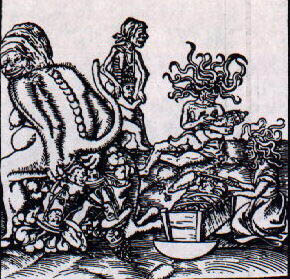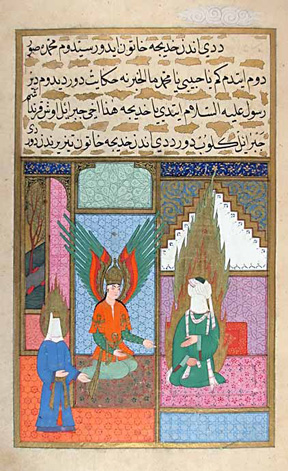
There is an excellent discussion of the origins and extent of apostasy laws in Islamic contexts by Dr. Ahmet Kuru, Porteous Professor of Political Science at San Diego State University in the online forum Qantara.

There is an excellent discussion of the origins and extent of apostasy laws in Islamic contexts by Dr. Ahmet Kuru, Porteous Professor of Political Science at San Diego State University in the online forum Qantara.

There are a number of issues on which Christians and Muslims agree, despite the historical antagonism that Islamophobia and Sectarianophobia perpetuate. For example, boycotting the power drink “Red Bull” in South Africa. A recent ad showed Jesus walking on the water after he drank “Red Bull”, stepping gingerly on the rocks that he could see beneath his feet in the water. The only miracle was in the drink, if you follow the ad. While the advertisers did not expect people to take the ad literally, gulp down their “Red Bull” and promenade without their water skis, the premise of the ad indeed denies the miracle, a denial that many Christians accept post-Hume with little problem. As reported in The Washington Post and picked up by a number of Muslim media outlets, such as Cii, South Africa’s Roman Catholic hierarchy told the faithful to give up “Red Bull” for Lent. And then, South Africa’s Muslim Judicial Council, in solidarity, joined the boycott by saying that an affront to the Prophet Issa (Jesus) is an affront to Muslims.
From the Catholic perspective, at least one that focuses less on “turn the other cheek” and more on “Get thee behind me, Satan,” the moral outrage is understandable. Think of a possible amendment to the catechism as follows:
Question: “What would Jesus do if a television commercial made fun of his miracles?
Answer: “If you believe that Jesus walked on “Red Bull”, then render unto “Red Bull”, but if you believe Jesus walked on water, then don’t drink this whited sepulcher of a beverage during Lent. Remember that at the wedding in Cana Jesus turned the water into wine, not “Red Bull.”
Although I have not found any specific news accounts, I suspect that the Bible-believer missionaries will forego “Red Bull” as well, even if they don’t hold fast to the Lenten fast.
But the fact that a major Muslim organization in South Africa has joined in condemnation of the ad is a cautious welcome sign, no matter what you think of the ad itself. Continue reading For the love of Jesus

Birth and Origin of the Pope by Lucas Cranach, illustration for Martin Luther’s “Against the Papacy at Rome, Founded by the Devil,” 1545
Satire is Religion
By Austin Dacey, Religion Dispatches, May 12
Scatological humor. Crude drawings mocking revered religious figures. I am speaking, of course, of Lucas Cranach’s Birth and Origin of the Pope [image above], one in a series of woodcuts commissioned by Martin Luther in the 1540s under the title “The True Depiction of the Papacy.†In it, an enormous grinning she-devil squats in the foreground, excreting the Pope along with a heap of bishops while in the background another infant pontiff suckles at the teat of a serpent-haired wet nurse.
Forget the South Park dust up; forget Everybody Draw Muhammad Day. If you want to see truly shocking anti-religious cartoons, you have to go back to the sixteenth century. Near the end of Luther’s life, his propaganda campaign against Rome grew increasingly vitriolic and his language grotesquely pungent. He took to calling his ecclesiastical enemies ‘asses,’ ‘dogs,’ ‘pigs,’ ‘blockheads,’ ‘basilisks,’ and ‘pupils of Satan,’ and the Pope himself ‘Her Sodomitical Hellishness’ and ‘fart-ass’ (no, it doesn’t sound much more dignified in German—fartz-Esel). Eric Cartman would be in awe. Continue reading Satire is Religion

Prophet Muhammad with the Angel Gabriel. Miniature from the Ottoman Empire, c. 1595 CE (Topkapi Museum, Istanbul)
Why Islam does (not) ban images of the Prophet
By Omid Safi, Newsweek, May 2, 2010
When a pair of adolescent and anonymous Muslim bloggers (“Muslim Revolution”) threatened the producers of South Park for depicting the Prophet Muhammad in a bear suit in an April 2010 episode, pundits responded by saying that the “Muslim Revolution” folks were extremist idiots (true) and that they were offended because Islam bans the depiction of the Prophet Muhammad (not true).
When the Danish cartoon controversies broke out in 2005, many pundits–and some Muslims–stated that Muslims were offended because Muslims have never physically depicted the Prophet.
That is actually not the case, and marks yet another example of what is at worst an acute sense of religious amnesia, and at best a distortion of the actual history of Islamic practices: Over the last thousand years, Muslims in India, Afghanistan, Iran, Central Asia and Turkey did have a rich courtly tradition of depicting the various prophets, including Prophet Muhammad, in miniatures. Continue reading Why Islam does (not) ban images of the Prophet

What the Danish Cartoon Controversy Tells Us About Religion, the Secular, and the Limits of the Law
By Winnifred Fallers Sullivan, Religion Dispatches, January 7, 2010
Review of: Is Critique Secular? Blasphemy, Injury, and Free Speech by Talal Asad, Wendy Brown, Judith Butler, and Saba Mahmood (University of California Press, 2009)
This very rich little book seems to me a very good place to begin the new decade. It is smart, informed, thoughtful, urgent—and properly unsettling. It is also very difficult to read quickly or to summarize in short order. It is well worth the effort.
The principal essays, by anthropologists Talal Asad and Saba Mahmood, take the Danish cartoon controversy as a starting point. They review the contexts of the publication of the satirical cartoons of Mohammed in Jyllands-Posten, a Danish newspaper, and the angry responses that ensued; they ask us to take seriously the fundamental incoherence of the assumptions about religion that underlie the dominant narratives of those events (dominant narratives that were repeated again this week in the stories about a recent attack on one of the cartoonists.) The book also includes an introduction by political scientist Wendy Brown and a response to the essays by philosopher Judith Butler. Continue reading More on the Danish Cartoons

The Prophet Muhammad, 17th century Ottoman copy of an early 14th century (Ilkhanate period) manuscript of Northwestern Iran or northern Iraq (the “Edinburgh codex”). Illustration of AbÅ« RayhÄn al-BÄ«rÅ«nÄ«’s al-Âthâr al-bâqiyah ( الآثار الباقيةة ; “The Remaining Signs of Past Centuries”). Source: Wikipedia article on Muhammad
Satanic or Silly: Does Yale Press Censorship of Cartoons Insult Muslims?
By Daniel Martin Varisco, Religion Dispatches, September 8, 2009
Two decades ago, the publication of Salman Rushdie’s The Satanic Verses caused a tsunami of protest in the Muslim world. The author was forced into hiding for nearly a decade after Ayatollah Khomeini called on Muslims to kill him and his publishers. Rushdie was accused of blasphemy, both for slandering the prophet Muhammad by subverting his character to Mahound (a medieval English term synonymous with the devil) and for reducing the holy city of Mecca to Jahiliya (a term used by Muslims to refer to the pagan past of Arabia). It was only a novel, but the fact that it was written by an Indian-born Muslim and published in the West was enough to frustrate even moderate Muslims.
Academic books rarely cause riots in the streets, but a forthcoming study on the recent Danish cartoon controversy may come close. Continue reading Satanic or Silly: Does Yale Press Censorship of Cartoons Insult Muslims?

Kurt Westergaard says he is too old to be afraid.
Danish cartoonist remains defiant
BBC News, April 5, 2009
The row over publication of cartoons of the Prophet Muhammad in a Danish newspaper resurfaced this week as Turkey held up the appointment of Danish prime minister as the new Nato secretary general. But as the BBC’s Malcolm Brabant reports from Denmark, the impact of that 2006 controversy has never gone away for those closely involved.
Dusk was falling, the curtains were open and the house was hyggelig – a Danish word that means cosy, welcoming and enticing – with scores of candles flickering around the open-plan sitting room.
Dressed in his favourite “anarchist” colours of red and black, Kurt Westergaard sat down to a nourishing Nordic repast of black bread, plaice and prawns.
Unwinding after a day at the coalface of his profession, the bohemian grandfather with a seadog’s beard and Father Christmas trousers appeared to be the epitome of Scandinavian tranquillity. Continue reading A DenMarked Cartoonist

Potent, powerful, and provocative. That’s what Nordstrom department stores have to say about Obsession, Calvin Klein’s cologne for men. These qualities are shared, no doubt, by another Obsession, a DVD currently being distributed by the Clarion Fund (http://clarionfund.org/), a nonprofit shell organization devoted to propagandizing against Islam. Subtitled “Radical Islam’s War Against the West,” copies of Obsession have been distributed as “paid advertising” in dozens of American newspapers, including the Charlotte Observer and the Chronicle of Higher Education.
Desperate for cash, traditional print media are not very fussy about their advertisers these days. Ann Caulkins, the publisher of the Charlotte Observer, told the paper’s religion reporter that the DVD met the newspaper’s criteria for ads: “We’re all for freedom of expression, freedom of speech. This is in no way reflecting our opinions, but it is something we allow,” she said, adding that the newspaper would not allow material that is racist, profane, or “offers graphic images of body parts,” which at least distinguishes the paper from anything in the CSI television franchise. Continue reading Obsession: Potent, Powerful, Provocative